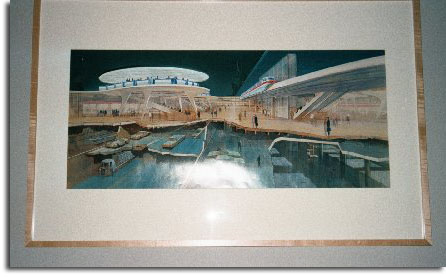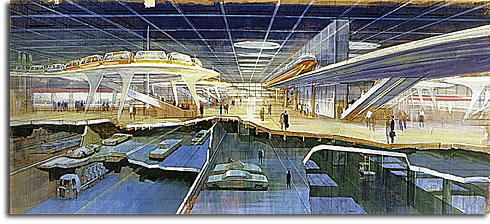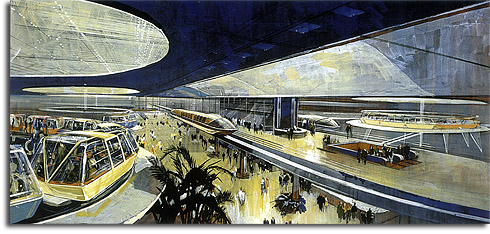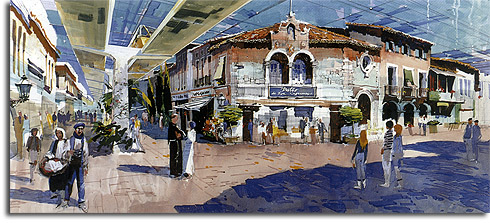In 1965, when Walt Disney moved into active planning for his “city of the future,” he needed artwork to get his vision across. To help sell the project to the Florida legislature and state officials whose permission he needed to create a new type of governmental district to govern his property in central Florida, Walt once again turned to Herb Ryman. Ryman, whose sketch had sold the Disneyland concept to financiers a decade earlier, joined the team that was toiling in secrecy to convert Walt’s dreams into some concrete and relatable vision.
As you can tell by glancing at our masthead, these were events for which we hold some interest here at Progress City.
 This concept for one of EPCOT’s outlying neighborhoods shows the satellite communities which would lie outside the city’s greenbelt. Residents would reach the city center via Peoplemover and other means.
This concept for one of EPCOT’s outlying neighborhoods shows the satellite communities which would lie outside the city’s greenbelt. Residents would reach the city center via Peoplemover and other means.A while ago I asked Imagineer George McGinnis if he’d ever worked closely with Ryman, and while they never worked directly together their artistic paths did cross thanks to EPCOT. Says McGinnis:
My first day on the job, 6-6-66, the project given me by Marvin Davis (Sr. Epcot Designer) was to design the modal split access between the Monorail and Walt’s “Experimental Prototype Community of Tomorrow” WedWay Peoplemovers. (Interesting to note in his film Walt didn’t mention “Monorail” — he use the term “Rapid Transit”. Probably he had in mind GE’s sponsorship.)
 Original concept for Walt Disney World Peoplemover by George McGinnis
Original concept for Walt Disney World Peoplemover by George McGinnisWalt wanted [McGinnis’s original Peoplemover design] enlarged for additional capacity. My immediate boss, Roger Broggie, walked into my office and found me working on the larger WedWay and asked, “Why I are you working on this?” I answered Walt asked me to do it. He quietly walked out. This helped me to understand Walt’s way of working — everyone worked for Walt and people respected this.
 In this photo of concept art for EPCOT’s transportation lobby, note the smaller, original Peoplemover design on the turntable to the left. Says McGinnis, “Ryman’s original painting with the small cars I had designed. I don’t remember if I added these — probably did, looks like my work.”
In this photo of concept art for EPCOT’s transportation lobby, note the smaller, original Peoplemover design on the turntable to the left. Says McGinnis, “Ryman’s original painting with the small cars I had designed. I don’t remember if I added these — probably did, looks like my work.” This is the same rendering as above, except that the Peoplemover cars have been altered to resemble McGinnis’s later, larger design that was created at Walt’s request. Also note the monorail’s change from something resembling the later Walt Disney World Mark IV trains to the more traditional Mark III design.
This is the same rendering as above, except that the Peoplemover cars have been altered to resemble McGinnis’s later, larger design that was created at Walt’s request. Also note the monorail’s change from something resembling the later Walt Disney World Mark IV trains to the more traditional Mark III design.I worked over one of Herb’s concept paintings for Walt’s EPCOT presentation, adding the larger WedWay (PeopleMover) Walt had asked me to design. I also used the larger WedWay in my painting for the same presentation in October 1966 to Florida’s governor.
We never heard from Walt after this on account of his illness that took his life in December.
 “Another Ryman painting with the enlarged WedWay cars Walt asked me to design. I selected this painting because it let me show off the cars in a better way.”
“Another Ryman painting with the enlarged WedWay cars Walt asked me to design. I selected this painting because it let me show off the cars in a better way.”While EPCOT city never came to be, some of its ethos rubbed off of the Florida property and on the theme park that bears its name. A few design concepts remained, too; EPCOT’s international shopping district was a revival of the old “International Street” expansion once planned for Disneyland – it would survive, in altered form, as EPCOT Center’s World Showcase.
Says McGinnis of those days:
I don’t think I ever worked directly with Herb, but our offices were close together and we had many conversations. I was always surprised how freely he spoke his opinions of WED operations.
Last thing he was working on was the Japan [Disneyland] concept and the day he left working at WED — he was in and out for projects — he stopped by my office to bid farewell, not knowing if and when he would be back. He passed away and John Hench remarked, “It is hard to imagine WED without working with Herb.”
Hard to imagine, indeed – and somewhat interesting to hear that from Hench, towards whom many of Ryman’s freely-spoken opinions were directed!
Special thanks to George McGinnis for sharing his memories for this article.











When I get past the artistic license of the paintings and the idealistic promise of PC, I think about what the place would look like it had been built as shown with glass truss ceilings, parking garages, and mid century placeholders, I’m not so sure it would age well at all. The design would have to be so flexible that it could evolve as the world changes and not be so locked. Would PC have turned out to be an American Brazilia? Thoughts?
Whenever I’ve seen renderings of the original EPCOT I’ve always thought about that… Two thoughts I have on that topic:
-AFAIK, the plans for EPCOT never got beyond the earliest conceptual stages before Walt passed and everything having to do with EPCOT was shelved. In the past, whenever Walt embarked on a totally new venture and was breaking new ground, the finished product would usually have just a faint connection to the original concept. (i.e.: Disneyland in the earliest stages was a collection of miniatures and/or small park with a train near the studio lot.) So had Walt lived to complete EPCOT, there’s still a good chance that the finished EPCOT would look very different from these earliest renderings. Would it look more modern? Maybe, maybe not, but it’s a possibility. I think about the Contemporary which at one point was thought to be the successor to the central hotel in EPCOT. Does it look horribly outdated? Not to my eyes, but it no longer looks very futuristic either.
-Walt emphasized flexibility and modular capabilities in the design. This was specifically highlighted in regards to the in-home appliances, but I’ve always had the (perhaps unfounded) impression that this would have extended into the design of the entire city. The point of the city was to be experimental, cutting-edge. That necessarily means that all aspects of the city will have to be replaced at some point in time. I’m not sure how well that could have been accomplished – especially without undermining the integrity of the city’s structures or bankrupting Walt Disney Productions (the project as a whole would undoubtedly require massive sponsorship so perhaps that’s the answer), but I imagine that flexibility would have been a design goal for Walt.
I think The Walt Disney Company’s failure to build EPCOT city is the biggest disappointment in the company’s history. They could have changed human civilization forever.
I recently spent the afternoon talking with Buzz Price and I asked him about the single-family homes at the edge of EPCOT (the ones in the third beautiful painting). He knew the densities were a bit low from an economic stand point but Walt told him that he wanted a place for his friends to live.
Great artwork. The more and more I have researched this project, the more I believe it really could have worked.
[…] Crawford at Progress City, USA discusses Herb Ryman’s concept art for the City of Tomorrow. He also rhapsodizes about Herb’s involvement with the 21st Century and some […]